Crystal Semiconductor was an audio mixer/DSP chip company. Founded in 1984 and based in Austin, TX, they focussed on analogue to digital converters and telecoms ICs before moving into PC audio in the early 90s. Their codecs and sound controller ICs were employed on a large number of sound cards during the DOS and early Windows era.
They were acquired by Cirrus Logic in 1991 who had produced some of the highest quality audio codecs mainly used in home theatre receivers. They retained the Crystal branding, marketing the Crystal codecs as Cirrus Logic's budget line. All these codec chips have the prefix "CS".
Generally speaking, Crystal codecs are considered of much higher quality than those of their direct competitors, Analog Devices, whose codecs should largely be avoided.
Here is a list of their most prolific audio codec chips in chronological order. Click on a link to go to more specific information on each one:
| Part # |
Released |
Comments |
| CS4215 |
1993 |
ISA Codec/DAC only (requires separate FM synth chip), “Mwave”-designation |
| CS4216 |
1993 |
ISA Codec/DAC only (requires separate FM synth chip), “Mwave”-designation |
| CS4248 |
1993 |
ISA Codec/DAC only (requires separate FM synth chip), pin-compatible with CS4231 |
| CS4231 |
1993 |
ISA Codec/DAC only (requires separate FM synth chip) (considered the best for its time) |
| CS4232 |
1995 |
Crystal's first proper sound controller/Codec chip (no need for external FM synth chip), ISA |
| CS4218 |
1996 |
ISA Codec/DAC only (requires separate FM synth chip) |
| CS4235 / CX4235 |
1997 |
ISA Controller/Codec, “CrystalClear” - buggy embedded FM from their CS4239 separate FM chip attempt. |
| CS4236 |
1997 |
ISA Controller/Codec, “CrystalClear” |
| CS4237 |
1997 |
ISA Controller/Codec with CrystalFM. As CS4236 but with SRS instead of “CrystalClear”. Sometimes found coupled with CS9236 wavetable chip. |
| CS4238 |
1997 |
ISA Controller/Codec, same as CS4237 but with QSOUND surround added |
| CS4280 |
1998 |
PCI Controller/Codec, “CrystalClear Legacy Support” |
| CS4281 |
1998 |
PCI Controller/Codec, “CrystalClear Legacy Support” |
| CS4297 |
1998 |
PCI Controller/Codec, “CrystalClear SoundFusion” 3D |
| CS4610 |
1998 |
PCI Controller/Codec, “CrystalClear SoundFusion” |
| CS4611 |
1998 |
PCI Controller/Codec, “CrystalClear SoundFusion” |
| CS4614 |
1999 |
PCI Controller/Codec |
| CS4622 |
2000 |
PCI Controller/Codec, “CrystalClear SoundFusion PCI Audio Accelerator” |
| CS4624 |
2000 |
PCI Controller/Codec, “CrystalClear SoundFusion” |
| CS4630 |
2001 |
PCI Controller/Codec, “CrystalClear SoundFusion” |
| CS4245 |
2004? |
? |
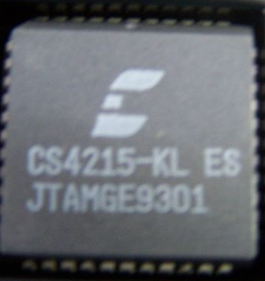 CS4215-KL, CS4215-KQ CS4215-KL, CS4215-KQ
Introduced: Early 1993
Type: Audio Codec
Sample Range: 4 kHz - 50 kHz
Package: 44-pin PLCC (-KL) or 100-pin TQFP (-KQ)
Known Revisions: C (Rev.0), D (Rev.1), E (Rev.2)
CS4215 is an MwaveTM audio codec from Cirrus Logic/Crystal, designed to take multiple analogue audio inputs, convert them into a digital signal, apply filtering and then convert them back into a combined/mixed analogue audio signal. The chip's revision is the letter immediately preceeding the date code.
MwaveTM MDSP1020 and MDSP2780 was a line of DSP chips created by IBM in joint partnership with Texas Instruments in late 1993/early 1994. It was not only designed for gaming audio, but also for voice/fax/modem use, so don't be surprised if a sound card with an Mwave chip also includes an onboard modem.
Datasheet: CS4215 |
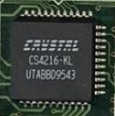 CS4216-KL, CS4216-KQ CS4216-KL, CS4216-KQ
Introduced: Late 1993
Type: Audio Codec
Sample Range: 4 kHz - 50 kHz
Package: 44-pin PLCC (-KL) or 44-pin TQFP (-KQ)
CS4216 is an MwaveTM audio codec from Cirrus Logic/Crystal, designed to take multiple analogue audio inputs, convert them into a digital signal, apply filtering and then convert them back into a combined/mixed analogue audio signal.
MwaveTM MDSP1020 and MDSP2780 was a line of DSP chips created by IBM in joint partnership with Texas Instruments in late 1993/early 1994. It was not only designed for gaming audio, but also for voice/fax/modem use, so don't be surprised if a sound card with an Mwave chip also includes an onboard modem.
Apparently MwaveTM DSPs do support FM synthesis compatible with Ad Lib and Sound Blaster, though I have yet to confirm this. There's a possibility the MDSP1020 was a sound chipset of which the MDSP2780 is the wavetable-only part - in this assumption, the MDSP1020 has a separate chip to provide FM synthesis.
The Mwave DSP was integrated into IBM's ThinkPad 755-series and PC 300 desktop series.
Found on:
Datasheet: CS4216 |
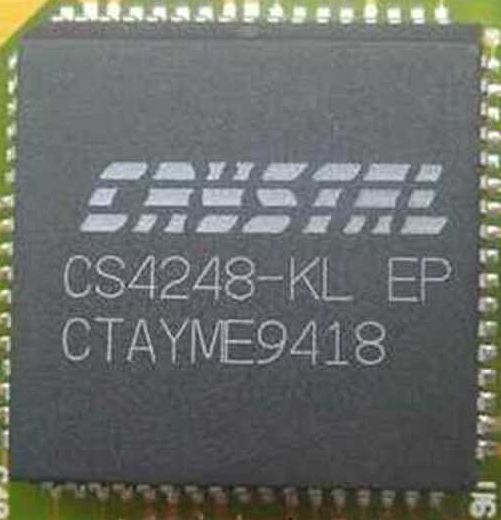 CS4248 CS4248
Introduced: 1993
Type: Audio Codec
Sample Range: 4 kHz - 50 kHz
Package:
68-pin PLCC (-KL) or 100-pin TQFP (-KQ)
One of Crystal's first audio codecs for PC sound cards, introduced in 1993.
16-bit input resolution.
Not full duplex.
Up to 50 kHz maximum input sampling rate.
This is a clone of Windows Sound System.
Found on:
Click here for a CS4248 datasheet. |
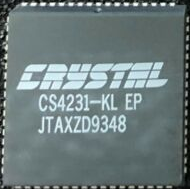 CS4231-KL, CS4231A-KL CS4231-KL, CS4231A-KL
Introduced: 1993
Type: Audio Codec
Sample Range: 4 kHz - 50 kHz
Package:
68-pin PLCC (-KL) or 100-pin TQFP (-KQ)
CS4231 and CS4231A are MwaveTM 16-bit audio codecs from Cirrus Logic/Crystal, designed to take multiple analogue audio inputs, convert them into a digital signal, apply filtering and then convert them back into a combined/mixed analogue audio signal.
The CS4231 is pin-compatible with the CS4248 and its Analog Devices sibling, AD1848, but adds MPC Level 2-compliance and further operating modes that enhance its functions. These include full duplex support, a programmable timer, mono output with mute control, mono input with mixer volume control, ADPCM and Big Endian audio data format support, and independent selection of capture and playback audio data formats.
The CS4231A is a pin-compatible upgrade to the CS4231 and CS4248, and is fully backward-compatible with those earlier codec ICs.
Found on:
Datasheets: CS4231 / CS4231A
Drivers |
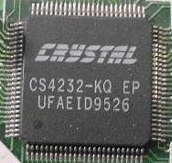 CS4232-KQ / CS4232-KM CS4232-KQ / CS4232-KM
Introduced: Early 1995
Type: Multimedia Controller and Audio Codec
Sample Range: 4 kHz - 50 kHz
Package:
100-pin TQFP (-KQ) or 100-pin PQFP (-KM)
The CS4232 was Crystal's first ISA Plug & Play and MPC Level 2-compliant codec, designed to take multiple analogue audio inputs, convert them into a digital signal, apply filtering and then convert them back into a combined/mixed analogue audio signal.
In addition to its codec functions, it had a joystick port, MPU-401-compatible MIDI interface, and an optional CD-ROM interface. It had no integrated FM chip so most cards that use the CS4232 would also have an OPL3 or compatible chip.
Requires DOS initialisation for the MPU-401 interface to work in Windows.
Found on:
- Acer Magic S32/S23 (S23 uses Crystal CS4232, S32 uses Creative's Vibra-16S chipset)
- Terratec Maestro 32/96 - with Crystal/Dream SAM9233 wavetable synthesizer
- Reveal SC500 Rev. 3 "SoundFX Wave"
- CrystaLake Multimedia 120 (1 MB) wavetable
- CrystaLake Multimedia 140 (4 MB) wavetable
- Ad Lib ASB4
- Turtle Beach Tropez Plus
- Orchid NuSound 32PNP
Click here for the CS4232 datasheet.
Drivers
It is usually recommended that you use the installation software from your sound card's manufacturer, but in the absence of those, try one of these:
Windows 3.x
Windows NT 3.51 and 4.0
Windows 95
OS/2 |
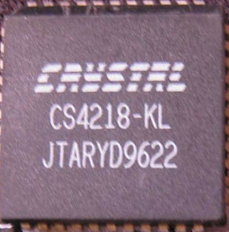 CS4218-KL CS4218-KL
Introduced: 1996
Type: Audio Codec
Sample Range: 4 kHz - 50 kHz
Package: 44-pin PLCC (-KL) or 44-pin TQFP
(-KQ)
A 16-bit audio codec from Cirrus Logic/Crystal, designed to take multiple analogue audio inputs, convert them into a digital signal, apply filtering and then convert them back into a combined/mixed analogue audio signal.
It was pin-compatible with their earlier CS4216 from 3 years before, but differs from CS4216 in that it runs from either 5V or 3.3V (CS4216 requires 5V), provides different serial modes and uses different digital filters.
Unlike its predecessors (CS4215 and CS4216), the CS4218 did not carry the MwaveTM moniker.
Datasheet: CS4218 |
  CS4236 / CS4236B CS4236 / CS4236B
Introduced: 1997
Type: Single-Chip Multimedia Audio System
Sample Range: 4 kHz - 50 kHz
Package:
100-pin TQFP (-JQ or -KQ)
The CS4236 was a complete audio solution on a single chip. It was fully compliant with the Microsoft PC '97 (MPC Level 2) and WHQL (Windows Hardware Quality Labs) audio requirements.
It supports full duplex, is Plug & Play, and features an FM synthesis on-chip compatible with Sound Blaster, Sound Blaster Pro and Windows Sound System.
In addition to its codec functions, it had a joystick port, MPU-401-compatible MIDI interface, and an optional CD-ROM interface.
CS4236 has low noise, does not suffer from the hanging note bug on the MPU-401 interface and decent compatibility with Sound Blaster, SB Pro and Windows Sound System.
The non-'B' revision requires DOS initialisation for the MPU-401 to work in Windows, whereas the B revision does not.
The non-'B' revision can be found on:
The 'B' revision can be found on Intel SE440BX motherboard (1998) as well as:
Click here for the CS4236 datasheet.
Drivers
It is usually recommended that you use the installation software from your sound card's manufacturer, but in the absence of those, try one of these:
Windows 3.x
Windows NT 3.51 and 4.0
Windows 95
OS/2 |
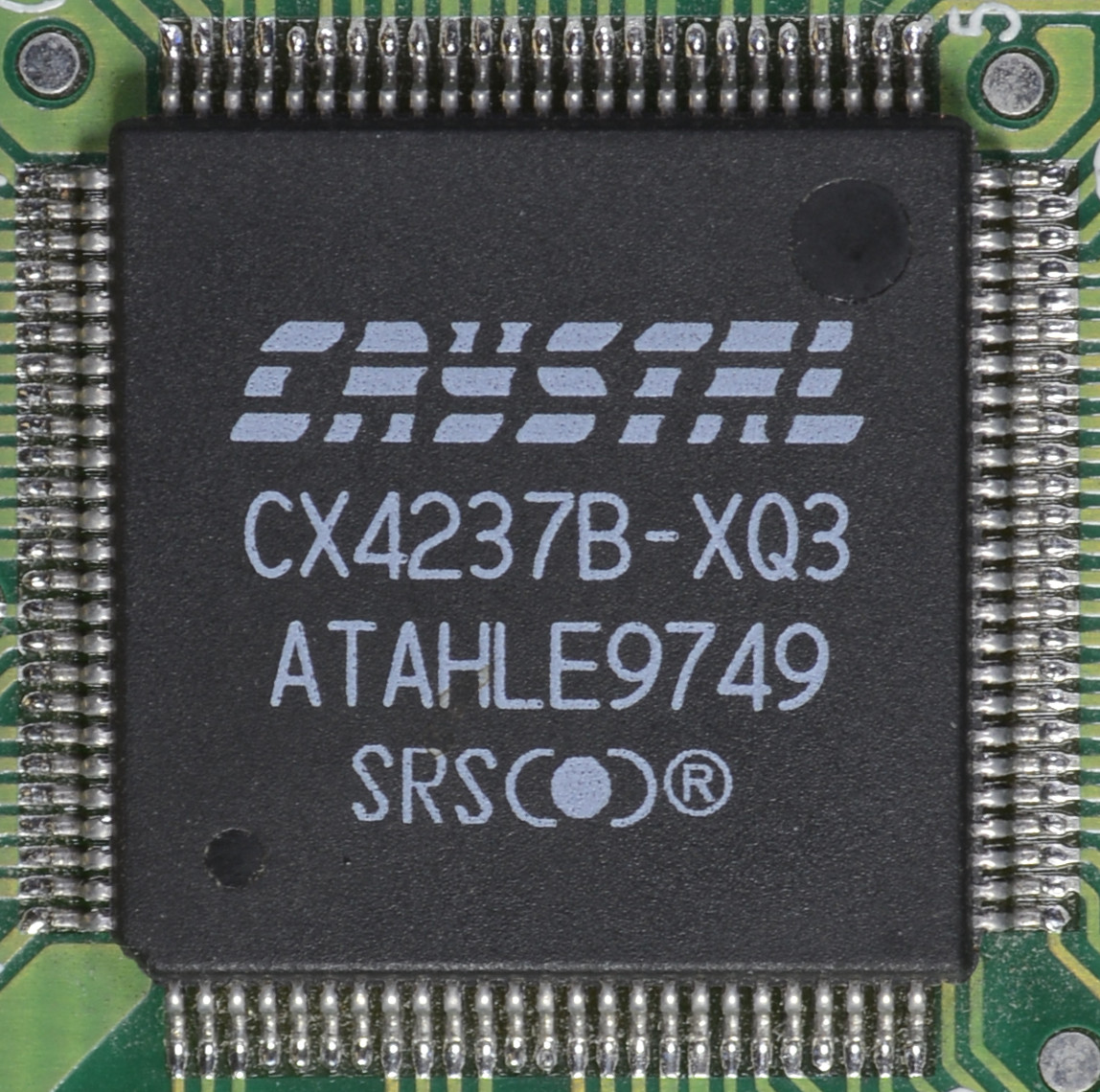 CS4237 / CS4237B CS4237 / CS4237B
Introduced: 1997
Type: Single-Chip Multimedia Audio System
Sample Range: 4 kHz - 50 kHz
Package:
100-pin TQFP (-JQ or -KQ)
The same chip as CS4236B but with SRS surround sound (by SRS Labs) replacing Crystal's own "CrystalClear" 3D audio.
Click here for the CS4237B datasheet.
Found on:
Drivers
It is usually recommended that you use the installation software from your sound card's manufacturer, but in the absence of those, try one of these:
DOS
Windows 3.x
OS/2 |
 CS4238 CS4238
Introduced: 1997
Type: Single-Chip Multimedia Audio System
Sample Range: 4 kHz - 50 kHz
Package:
100-pin TQFP (-JQ or -KQ)
The same as CS4237 but has QSOUND surround sound (from QSound, Inc.) instead of SRS.
Drivers
It is usually recommended that you use the installation software from your sound card's manufacturer, but in the absence of those, try one of these:
Windows 3.x
OS/2 |
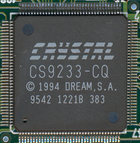 CS9233 / CS9236 CS9233 / CS9236
Introduced: 1997
Type: Wavetable Synthesizer
Package: 144-pin TQFP (-CQ)
A wavetable synthesis chip with reverb and chorus, so supports GM (General MIDI). No DAC. Requires DOS initialisation for the MPU-401 (UART mode) to work in Windows.
Usually coupled to a 1 MB or 4 MB wavetable sample ROM such as CS4110 or CS4111, with 128 melodic instruments and 47 percussion sounds, as it has no built-in memory for sample storage.
Its ROM soundfont is typical of old 1 and 2 MB ROMs. This is covered also in my Wavetable Audio page under Crystal/Dream SAM9233. |
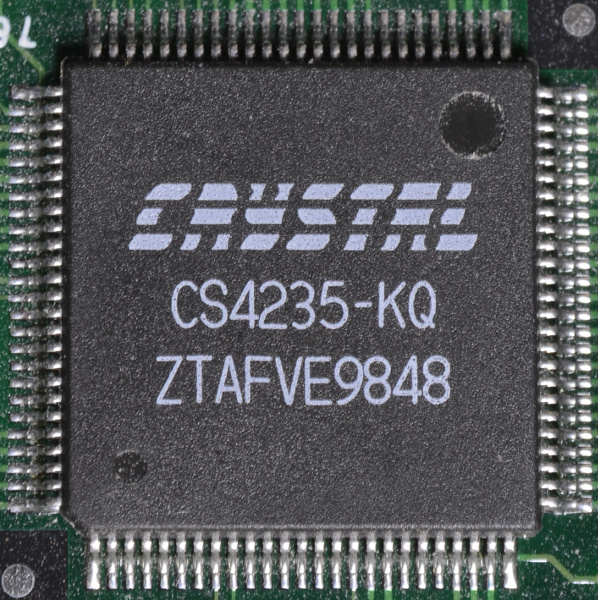
CS4235 / CX4235 / CS4239
Introduced: Late 1997
Type: Single-Chip Multimedia Audio System
Sample Range: 4 kHz - 50 kHz
Package:
100-pin TQFP (-JQ or -KQ)
The CS4235 is a slightly later version of the CS4236B, adding what Crystal called "CrystalClear" 3D audio.
It supports full duplex, is Plug & Play, has an integrated FM synthesizer on-chip compatible with
Sound Blaster, Sound Blaster Pro and Windows Sound System.
In addition to its codec functions, it had a joystick port, MPU-401-compatible MIDI interface, and an optional CD-ROM interface.
Apparently the CS4235 got a very glitchy OPL3 FM synthesizer, so it's advisable to avoid cards or motherboards that have this chip. There are numerous reports of its FM audio sounding pretty dreadful.
The CX4235 is the same as a CS4235 - Crystal for some reason decided to use a CX prefix.
A low-power version of the CS4235 was also released, called CS4239.
The CS4235, CX4235 and CS4239 can be found on the following sound cards:
Click here for the CS4235 datasheet.
DOS Drivers |
 CS4297 CS4297
Introduced: 1998
Type: Audio Codec
Sample Range: 4 kHz - 50 kHz
Package:
48-pin TQFP (-KQ or -JQ)
The CS4297 is an AC'97-compatible audio codec. Its full name is CrystalClear SoundFusion Audio Codec '97. It is supposed to be paired with something like a CS4610.
The CS4297 Audio Codec ’97 and CS4610 PCI Audio Accelerator were the first members of the SoundFusion family. |
 CS4610 / CS4611 CS4610 / CS4611
Introduced: 1998
Type: PCI Audio Accelerator
Sample Range:
Package:
100-pin MQFP or 128-pin TQFP
The CS4610 and CS4611 are "CrystalClear SoundFusion" PCI audio accelerator chips. They fully support DirectX 5.0 3D Positional Audio, Dolby Digital AC-3, DDMA for legacy support in DOS in addition to Crystal's own proprietary CCLS (CrystalClear Legacy Support).
The CS4611 was an embedded audio chip found on the Intel SE440BX motherboard from 1998 alongside the CS4236.
Compliant with AC'97 2.0. Cards/boards that use these chips provide S/PDIF digital input and output.
Click here for the CS4610/11 datasheet. |
 CS4614 CS4614
A PCI audio chip. |
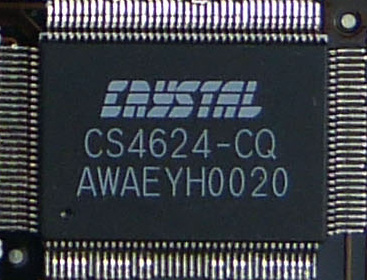 CS4622 / CS4624 CS4622 / CS4624
A PCI audio chip, full name is CrystalClear SoundFusion PCI Audio Accelerator.
Among other things it provides an "Enhanced Game Port", able to send and receive digital data packets over the game port - designed for joysticks and other devices that require more than the 15-pin analogue game port could traditionally handle.
The CS4624 is a cost-reduced version of the CS4622, with no support for Dolby Digital AC-3 and a reduced clock speed.
Datasheets: CS4622/4624 |
 CS4280, CS4281 CS4280, CS4281
Introduced: 1998
Type: Single-Chip Multimedia Audio System
Sample Range: 4 kHz - 50 kHz
Package:
100-pin MQFP (-CM) or 128-pin TQFP (-CQ)
The CS4280 and CS4281 are PCI audio chips with legacy DOS compatibility via both PC/PCI, Distributed DMA and what Crystal called "CrystalClear Legacy Support". They have an integrated FM synthesizer, hardware volume control, an MPU-401 interface, zoom video port and game port.
The CS4280 is pin-compatible with the earlier CS4614, CS4622/CS4624, and is usually coupled with the Crystal CS4297 audio codec.
CS4280 is found on the JoyTech Twister 3D sound card as well as the Pine Technology PT2620.
Datasheets: CS4280 / CS4281. |
 CS4245 CS4245
Introduced: 2004
Type: Audio Codec
Sample Range: 4 kHz - 192 kHz
Package:
48-pin LQFP
Click here for the CS4245 datasheet. |
 Crystal Semiconductor
Crystal Semiconductor













